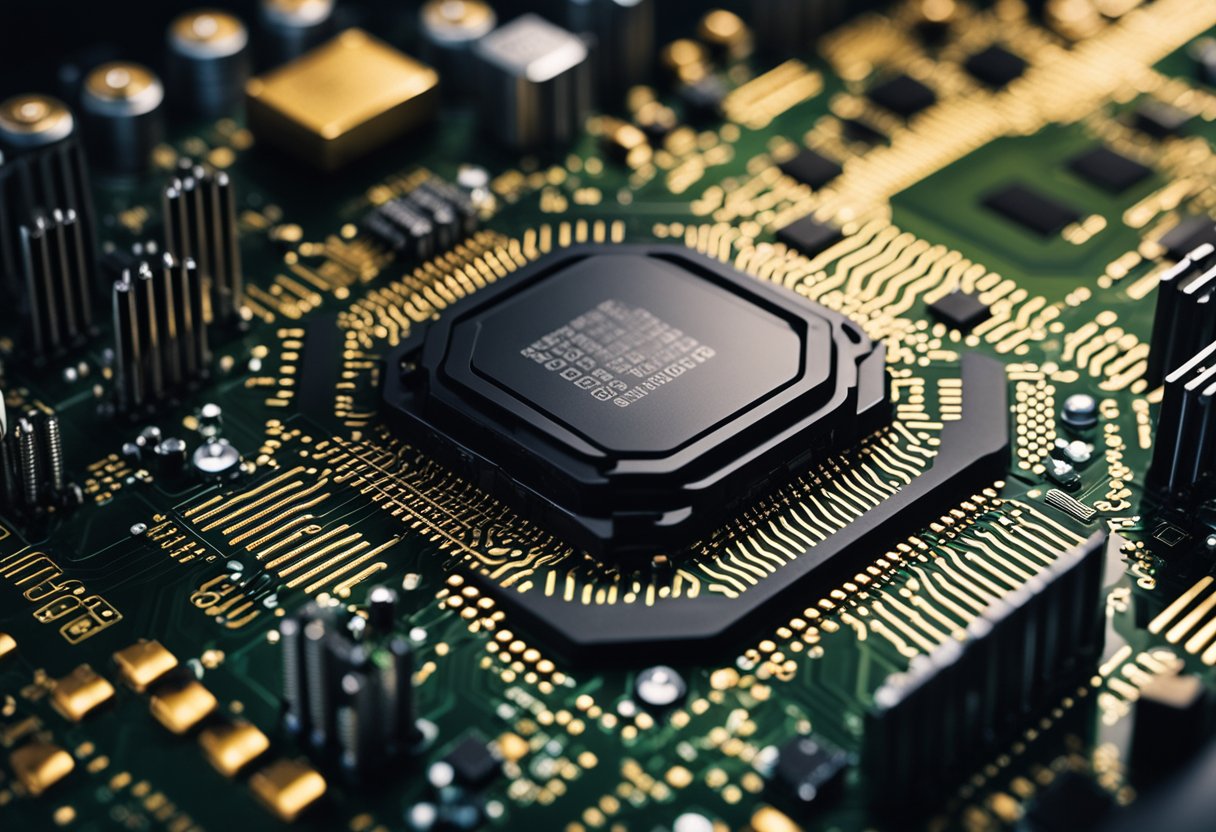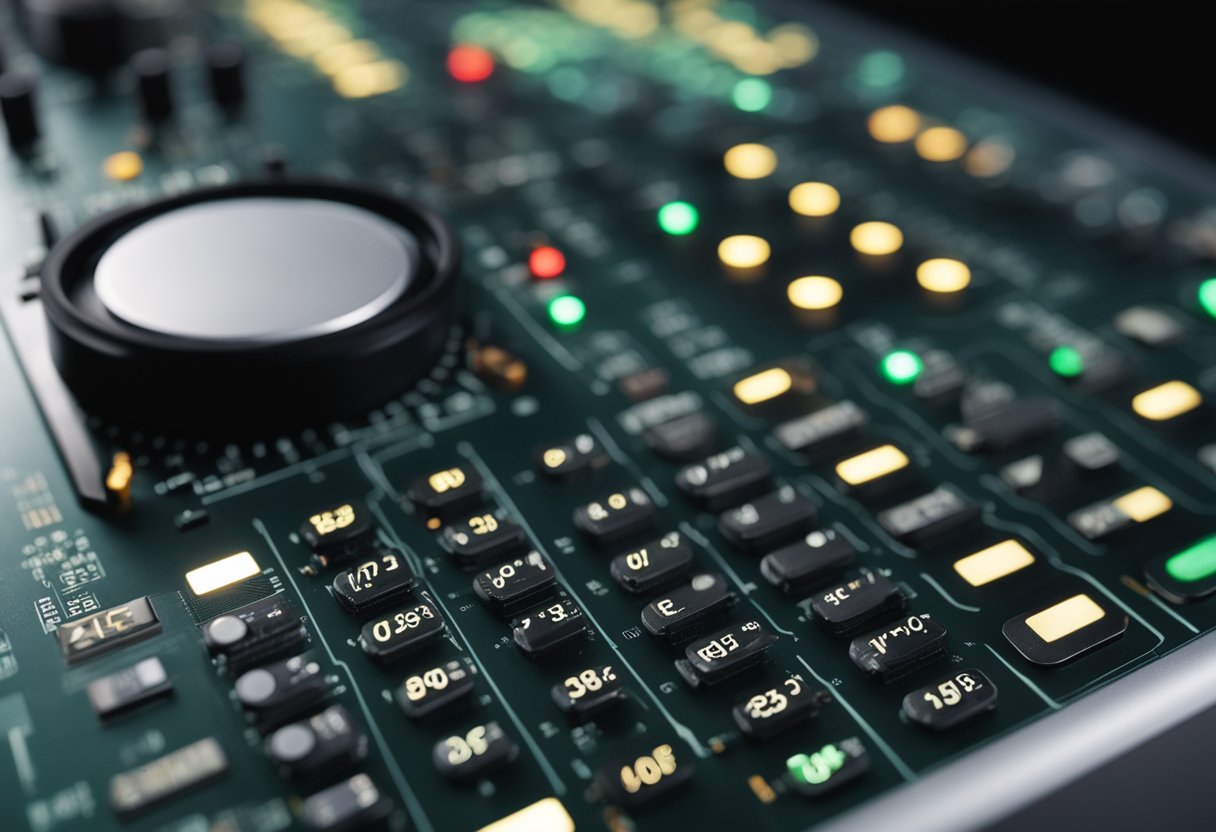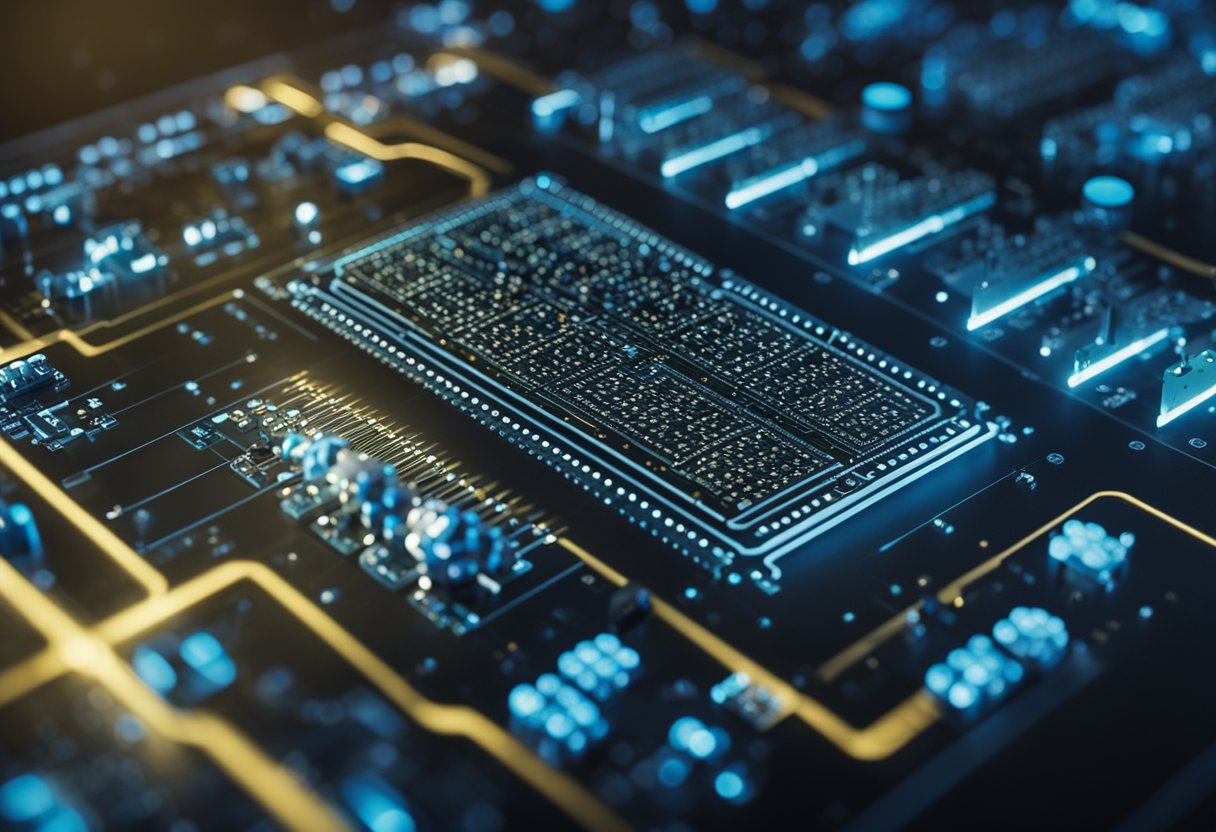Understanding which parts of a computer execute program instructions is critical to grasping how computers operate. At the heart of this process is the Central Processing Unit (CPU), often referred to as the “brain” of the computer. The CPU plays a pivotal role in running the software by performing basic arithmetic, logic, controlling, and input/output operations specified by the instructions of the program.

The execution of program instructions is not handled by a single component; rather, it is a concerted effort that involves various elements of the computer. Memory systems hold the instructions and data, while specific areas within the CPU, such as the Control Unit (CU) and Arithmetic Logic Unit (ALU), work synergistically to decode and carry out commands. Meanwhile, auxiliary components such as input/output devices and secondary storage all contribute to a computer’s ability to run programs effectively.
Key Takeaways
- The CPU is central to executing program instructions within a computer.
- Memory storage is essential for holding program instructions and data for CPU access.
- Program execution is a complex process involving multiple computer components.
The Central Processing Unit (CPU)

The CPU serves as the cornerstone of modern computing, decoding and executing program instructions through a complex harmony of components and processes. It manages data flow, carries out operations, and communicates with memory, input, and output devices to facilitate the function of a computer.
Understanding the CPU
The Central Processing Unit, also known as the microprocessor, is the primary component of a computer that processes instructions. It performs the essential operations of the machine cycle, which includes fetching, decoding, and executing instructions, as well as storing results.
CPU Components and Their Roles
Within the CPU, the Control Unit (CU) orchestrates the sequencing of operations, directing the Arithmetic Logic Unit (ALU) to perform mathematical calculations and logic operations. Registers provide fast storage for immediate data, with the accumulator and temporary register facilitating quick access during the processing.
Clock Speed and Performance
CPU clock speed, measured in gigahertz (GHz), indicates the number of clock cycles a CPU can perform per second, directly influencing its performance. Higher clock speeds enable faster data processing, although this is influenced by overall CPU architecture.
Memory Hierarchy and CPU
The cache, RAM (Random Access Memory), and ROM (Read-Only Memory) form the memory hierarchy that supplies data to the CPU. Primary memory, or main memory, holds instructions and data that are actively being processed by the CPU.
Instruction Cycle and Execution
The instruction cycle, consisting of fetching the instruction from memory, decoding the opcode, determining the operand, and performing an operation, is crucial for program execution. The instruction register holds the current instruction, while the machine cycle repeats this process for each consecutive instruction.
CPU Architecture
CPU architecture, or instruction set architecture (ISA), defines the set of functionalities and machine language the CPU can execute. Various architectures optimize different computational tasks, with a trade-off between complexity and performance.
Programming and CPU Interaction
Programming languages, such as Python, produce code that is ultimately translated into the instruction set the CPU can understand. Each statement in a higher-level language corresponds to multiple machine-level instructions that the CPU will execute.
The Role of Pipelining
Instruction pipelining enhances CPU throughput by dividing the processing of instructions into several stages, allowing multiple instructions to overlap in execution. This optimization in the CPU’s workflow can greatly improve processing efficiency.
Input/Output Management
The CPU communicates with input devices and output devices via the bus system and dedicated ports, ensuring that user interactions and data outputs are comprehensively managed. This integration allows for seamless data exchange with the CPU.
Advanced CPU Technologies
Recent advancements in CPU technology include the introduction of multicore processors, enhancing parallelism, and optimizing energy efficiency. These technologies continue to expand the capabilities of CPUs to meet the demands of complex software applications and computational tasks.
Memory Systems

In the context of computers, memory systems function as the cornerstone for storing and retrieving data. They are fundamental for the execution of software by reliably preserving the instructions and information that a system processes.
Types of Memory
Primary memory, also known as main memory, is where a computer temporarily stores data that is actively being used. Two main types of main memory are Random Access Memory (RAM) and Read-Only Memory (ROM). RAM is volatile and stores data that can be accessed and modified by the processor, making it essential for tasks requiring speed and flexibility. ROM, on the other hand, is non-volatile and typically contains firmware, holding data that is not intended for regular modification.
Memory Addresses and Storage
Each location in memory is identified by a memory address, which allows the processor to access and manage stored data. Addressing modes, such as immediate, direct, indirect, and indexed, determine how these addresses are utilized to retrieve or store data. The addressing mode chosen affects how the CPU accesses data and can influence the speed and efficiency of program execution.
Data Transfer and Memory
The flow of data between memory and the CPU is managed by buses, acting as communication highways. Typically, this includes an address bus to carry the address of the memory location, and a data bus to carry the actual data. This process is vital for executing both memory reference instructions, which manipulate data in memory, and register reference instructions, which involve the CPU’s registers – small, fast storage locations within the CPU.
Software and Memory Interaction
Both the operating system and software rely on memory to function. When a program is launched, it’s loaded into RAM, with the operating system managing the allocation and deallocation of memory for different processes. Cache memory also plays a role by storing frequently accessed data to quicken access times. The coordination between software and memory is pivotal for a computer to efficiently carry out computer instructions and perform tasks.
Control Unit (CU)

The Control Unit (CU) is the core component of a computer’s Central Processing Unit (CPU) that orchestrates the execution of instructions through the machine cycle, guiding the process through a sequence of clock cycles, and interacting with the CPU registers.
Function of the Control Unit
The primary function of the CU is to interpret the instructions from a computer’s memory and initiate the proper sequence of micro-operations that constitute the instruction cycle. It does this by converting instructions into control signals that direct the systematic execution of the program. These signals manage the data flow within the CPU, as well as between the CPU and other system components.
Instruction Decoding and The CU
During instruction decoding, the CU interprets the opcode (operation code) of each instruction, which specifies the operation to perform, while the operand points to the data or the register involved. The CU utilizes a combination of logic gates and electricity to generate control signals that activate the appropriate CPU paths necessary to perform logical operations and execute the instruction set.
CU and Registers
Registers, which include the program counter (PC), address register, instruction register, and accumulator, are essential for the CU’s operation. The program counter keeps track of the machine cycle by holding the memory address of the next instruction. The CU uses the address register to access instruction and data locations, while the instruction register holds the instruction currently being executed. For arithmetic and logical operations, the CU works with the accumulator as a sort of workspace.
Signal Coordination
Coordinating signals during the machine cycle relies on the precise timing of clock cycles. The CU signals the movement of data from the registers to the Arithmetic Logic Unit (ALU), regulates the operation of the ALU, and moves the result back into the appropriate register or memory location. Through regulated timing, the CU synchronizes the data processing events with the clock cycle, ensuring that the entire system works efficiently and effectively.
Arithmetic Logic Unit (ALU)

The Arithmetic Logic Unit (ALU) is an integral part of the computer’s central processing unit (CPU), performing all arithmetic and logical operations. It is crucial for the execution of program instructions as it processes the data based on the opcode from the instruction register.
ALU Operations
The ALU carries out two main types of operations: arithmetic and logical. In arithmetic operations, it performs basic calculations such as addition, subtraction, multiplication, and division. Logical operations include various bitwise actions like AND, OR, NOT, and XOR, which manipulate data at the binary level.
The ALU in Computing
Within computing systems, the ALU is a fundamental component that makes up the computational ability of the CPU. Each instruction executed by the CPU is comprised of an opcode, which specifies the operation to be performed, and the operand, which provides the data or the reference to the data. The ALU utilizes a series of logic gates to process these instructions efficiently during the machine cycle.
Interaction With Other CPU Parts
The ALU interacts closely with other parts of the CPU, such as the control unit (CU) and various registers. The CU decodes the instruction and directs the ALU to perform the correct operation. The program counter keeps track of the instruction sequence, while the instruction register holds the instruction currently being executed. Data is often temporarily stored in registers during processing.
Modes of Operation
The ALU operates in different modes depending on the instruction received. The mode field of the instruction can alter how the ALU processes an operand, such as shifting between arithmetic and logical computation modes. Additionally, the ALU uses the address field to fetch operands from memory locations when needed. These modes ensure that the ALU can handle a wide range of computational tasks, making it a versatile tool in the processing of program instructions.
Programming Integration
Integrating programming elements into a computer system involves intricate processes where software commands and hardware components harmonize to execute intricate tasks. The journey from a line of code to an action performed by a machine underscores the marvel of modern computing.
Software Integration With CPU
The Central Processing Unit (CPU) is the main executor of program instructions. When software applications are run, they communicate with the CPU through an instruction set that is specific to the hardware. This allows the CPU to interpret and perform tasks as dictated by the program.
Code Execution Process
The execution of code begins when the CPU retrieves instructions from the memory. Each statement in a programming language gets translated into a set of machine language instructions that are directly executable by the CPU, like the simple print command which outputs data.
Programming Languages and the CPU
Different programming languages, whether it’s high-level like Python or low-level like assembly, communicate with the CPU through a conversion into machine code. The CPU’s efficiency in interpreting these instructions is pivotal for the smooth operation of software applications.
Operating System Role
An operating system acts as an intermediary between software and hardware. It manages the CPU’s time and resources by handling program requests for memory allocation, processing time, and input/output operations.
User-Level Interaction
Input devices such as keyboards and output devices like monitors are integrated by the operating system, enabling users to interact with computer programs. The operating system translates user actions into a language that the CPU can understand and respond to with the desired output.
Auxiliary Components
In ensuring that a computer executes program instructions effectively, several auxiliary components play vital roles. These components handle the intricacies of data communication, power delivery, device connectivity, and performance optimization.
Data Buses and Communication
Data buses act as the highways within a computer, carrying information between various components. Memory addresses are critical for directing data to the correct location. A bus typically refers to either the address bus, which transports memory addresses, or the data bus, which carries the actual data. These buses enable communication between the CPU, input/output devices, and memory, making the execution of program instructions possible.
Power Supply and Electricity
The power supply converts incoming electricity from a wall outlet into low-voltage power suitable for the computer’s internal components. Consistent power delivery is essential for maintaining the stability of the CPU and other parts, such as output devices and input devices. A computer’s performance and ability to execute instructions are contingent on a stable and adequate power supply.
Peripheral Devices and Interfaces
Peripheral devices, connected through various ports, are essential for a computer’s operation. Interfaces such as USB, HDMI, and Ethernet facilitate the connection of input devices like keyboards and output devices such as monitors. These interfaces use input/output protocols to regulate data exchange with the CPU and memory, supporting the execution of instructions.
Performance Tuning Tools
Certain tools are key for refining a computer’s performance. These include software for adjusting system settings and hardware designed to monitor and enhance the operation of the CPU and memory. By fine-tuning these components, a user can maximize efficiency and ensure swift and accurate execution of program instructions.
Frequently Asked Questions
Addressing some of the most common queries regarding how computer components work together to execute program instructions.
What component is primarily responsible for executing program instructions in a computer?
The Central Processing Unit (CPU) is the primary component responsible for executing program instructions. Commonly known as the brain of the computer, it carries out command processing and operational functions.
How does the CPU relate to the processing and execution of computer programs?
The CPU processes and executes computer programs by performing a continuous sequence of fetch, decode, and execute steps. Every single instruction from a program is handled sequentially, ensuring the program functions as intended.
What role does the program counter play in running a computer program?
The program counter is a specialized register within the CPU that keeps track of which instruction should be executed next. It plays a crucial role by holding the address of the next instruction, guiding the sequence of the program’s execution.
Which internal part of the computer is critical for running software applications?
In addition to the CPU, the main memory is critical for running software applications as it stores the programs and data currently in use, making them quickly accessible to the CPU during execution.
How is data stored and processed within a computer to facilitate program execution?
Data is stored in the computer’s main memory and is processed by the CPU in a cycle of steps known as the fetch, decode, execute cycle. This mechanism ensures that instructions are carried out correctly and in the right order.
In terms of computer architecture, which component is tasked with carrying out program instructions?
Regarding computer architecture, the CPU, specifically its ALU (Arithmetic Logic Unit), and control unit work in tandem to carry out program instructions. Depending on the instruction, different parts of the CPU may be utilized to execute a given task.
